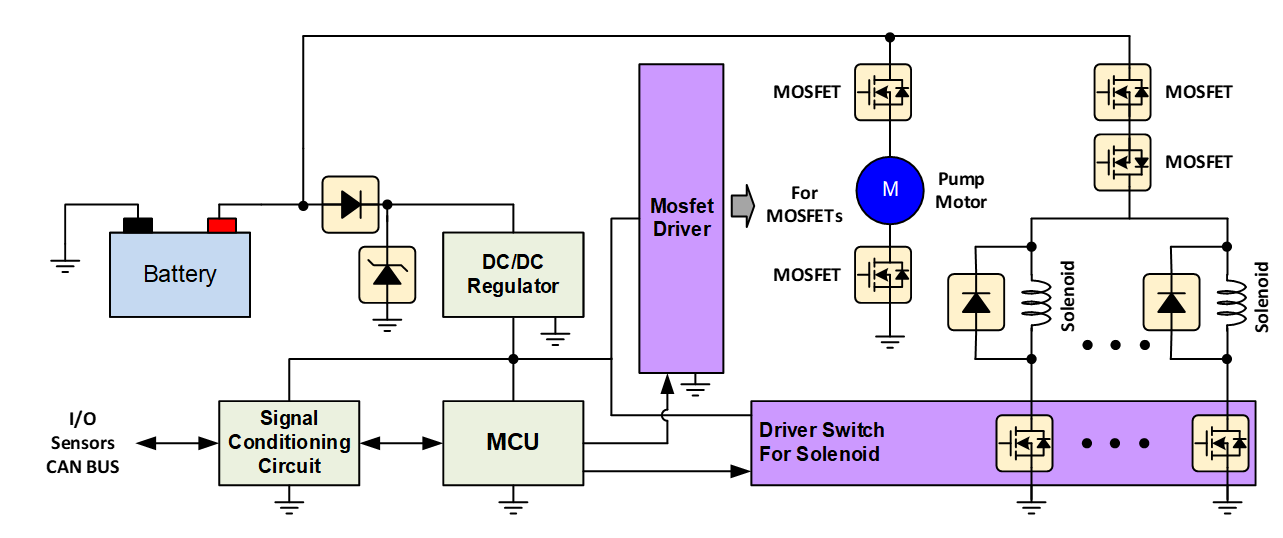
During vehicle operation, when encountering emergency situations or sudden obstacles, most drivers will instinctively step on the brake pedal as hard as possible in an attempt to decelerate quickly. However, the sudden and excessive braking force can cause the wheels to lock up, transitioning the friction between the tires and the road from high-coefficient static friction to low-coefficient kinetic friction. This can result in loss of control, such as skidding or sliding, significantly reducing the vehicle’s ability to avoid obstacles. To prevent loss of control and wheel skidding during emergency braking, modern vehicles are now equipped with Anti-lock Braking System (ABS) as standard.
The Anti-lock Braking System monitors the rotational speed of the four wheels and the vehicle speed difference. By adjusting the hydraulic pressure to each wheel’s brake caliper, the ABS system can maintain a stable control state during deceleration through a cycle of applying and releasing brake pressure 20-25 times per second, similar to the “pumping” of the brake pedal. This allows the driver to maintain steering control and minimize damage.
The ABS system consists of an electronic control unit (ECU), wheel speed sensors on each of the four wheels, a hydraulic pump, and a brake hydraulic valve body. The wheel speed sensors on each wheel transmit the rotational speed signals to the ECU.
The ECU continuously calculates the vehicle speed and the difference between the wheel speed and the vehicle speed, known as the slip ratio. When the slip ratio becomes too high, the ECU issues a control command to adjust the brake calipers of each wheel, maintaining the wheel slip ratio between 10% and 30% to prevent wheel lockup. Under this braking mode, good longitudinal and lateral adhesion between the tires and the road is ensured, effectively preventing the vehicle from skidding, fishtailing, or losing steering during braking, improving the directional stability of the vehicle during braking. Additionally, the ABS system maintains the braking force at an optimal level, shortening the braking distance and reducing the wear and tear on the tires.
To achieve the goal of improving vehicle braking safety and control performance, MOSFETs, as electronic devices, are widely used in ABS systems due to their ability to effectively control current and power.
In ABS systems, MOSFETs are primarily used to control the adjustment and switching of brake fluid pressure. When the vehicle performs emergency braking or needs to prevent tire lockup, the ABS system changes the solenoid in the brake hydraulic valve body through PWM signals. By controlling the pressurization, holding, and depressurization of the internal wheel cylinder within the controller, the opening and closing of the brake caliper is achieved, balancing the rotation and grip of the tires. MOSFETs, as electronic switches, can adjust the brake pressure according to the control signal, thereby controlling the tire grip.
In addition to the brake hydraulic valve body, the hydraulic pump control circuit is also mainly based on power MOSFETs, supplemented by protection circuits and isolation measures to ensure reliability. A dedicated self-diagnosis circuit is also designed for fault detection.

MOSFETs offer advantages such as fast switching speed, low power consumption, and high efficiency, making them ideal for ABS systems. They can quickly switch the pressure in the brake hydraulic system to adapt to changes in vehicle braking needs. Additionally, MOSFETs can effectively handle high currents and high-temperature environments, which is particularly important in automotive ABS systems.
The solenoid in the brake hydraulic valve body is controlled by the MCU in the ECU. In addition to the main control MOSFET, there are also freewheeling diodes used to protect the solenoid coil and control the application circuit. During braking, when the solenoid is energized, current flows through the solenoid coil, causing the valve to open and allowing hydraulic pressure to enter the valve body to apply braking force. However, when the solenoid is de-energized, the pressure in the hydraulic valve body is fixed, preventing continuous application of braking force and causing tire lockup. In the application circuit, due to the residual magnetizing current in the solenoid coil, a freewheeling diode is used to allow the current to decay smoothly, preventing the occurrence of voltage spikes and protecting the electronic devices in the circuit from damage.
Freewheeling diodes typically have high reverse voltage capability and high pulse current capability, enabling them to withstand the high voltage and high current operating environment of automotive ABS systems. Additionally, they have fast switching speeds and low forward voltage drop, reducing energy loss and ensuring efficient system operation.
Taiwan Semiconductor offers AEC-Q101 qualified PRD products. In addition, Taiwan Semiconductor can also provide customers with automotive-grade MOSFETs and TVS for ABS system protection devices to meet the requirements of automotive-specific test standards such as ISO 7637-2, ISO 10650, and ISO 16750-2.
Products
Read more articles
- Beyond Braking: Advanced Driver Assistance Systems (ADAS) for a Safer Driving Experience
- Powering the Electric Revolution: The Body Control Module (BCM) in Automotive
- Battery management system (BMS): Protecting and Managing Your Electric Vehicle
- Advanced LED Solutions for Enhanced Vehicle Visibility
- Power Components for On-Board Chargers (OBC): A Comprehensive Overview
- MOSFETs and Diodes: Key Components in Reverse Polarity Protection
- Sensor Fusion for Supplementary Restraint Systems (SRS)


